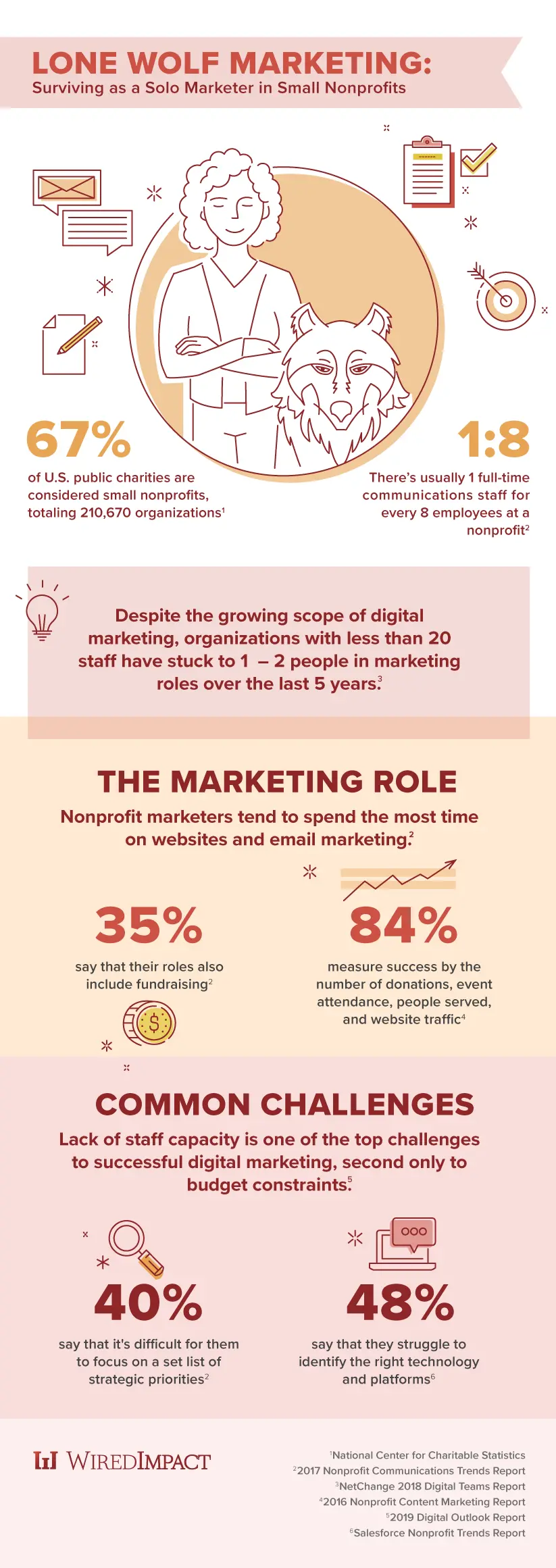Marketing, party of one? At small nonprofits, it’s not uncommon for there to be one staff member who wrangles all of the marketing and communications. And while you get a lot done, it can feel a little isolating when you don’t have other like-minded folks to talk strategy and share the load.
If you’re wondering how to succeed in an environment with limited resources or team support, learn three steps to surviving as your nonprofit’s lone marketing wolf.
About Lone Wolf Marketing
In nature, a lone wolf is one that’s separated from the pack, forced to manage on its own and often struggling to find the next meal. Even if your nonprofit has a handful of staff that works well as a team, being the only staffer wearing the marketing hat can mean that you’re on your own to find the resources or technology you need, plus advocate for best practices.
If you’re a lone wolf marketer, these scenarios will probably sound familiar:
- There’s not enough time in your work day to get it all done, but there’s no one else to delegate to unless you recruit an intern or volunteer.
- You have a little bit of marketing money in the budget, but you spend a good chunk of time looking for free or discounted options to fit most of your needs.
- There’s not a clear line between marketing, fundraising, operations, event management or administrative tasks among the staff.
- The board and executive director want your marketing efforts to be on par with some of the larger or more well-known nonprofits. Maybe you’ve heard of charity: water?
- You do a lot of things for the first time at your organization since there aren’t existing templates or processes. You might not have the data you need to make informed decisions.
By the Numbers: Marketing at Small Nonprofits
Who is the lone marketing wolf? I took a look at some of the most recent research and reports. While not all of these numbers are exclusive to small nonprofits, smaller organizations are represented in the data. Additionally, the marketing challenges included in the data can seem even more insurmountable at organizations with fewer staff and resources.

3 Steps to Survive (and Thrive)
Thinking about running for the hills? Don’t scamper off just yet! It’s possible to create a manageable workload with room for creativity and collaboration. Follow these three steps as part of your survival plan.
(1) Plan and Schedule Your Marketing Efforts
You’ve heard it before, and it definitely applies here: the best defense is a good offense. And in this case, your offense is a strategic marketing plan paired with an editorial calendar. Going through the process of making an annual marketing plan is a crucial step because it sets a clear roadmap and determines how you’ll measure success. It’s also one of the best tools for limiting the scope of your work—if you’re honest about how much you can accomplish with staff capacity and budget.
Following up on your marketing plan with an editorial calendar helps you put rubber to the road, so the speak, by scheduling marketing tasks for the weeks and months ahead. You’ll be able to identify times where you might need extra support (or need to cut back), and you might find places where you can repurpose your work to meet multiple goals.
Here are some things to keep in mind:
- Set appropriate goals. Your marketing goals should support organizational goals and be reasonably within reach based on your current benchmarks. Don’t worry about competing with larger organizations or using industry benchmarks that aren’t relevant to you.
- Focus on your target audience personas. If you limit your work to the topics and channels that best connect with your target audience, the pressure comes off to “go viral” and figure out the impossible task to “build awareness.” Prioritize the areas where their goals and your organizational goals overlap.
- Measure what’s working and what’s not. Organizations of all sizes struggle to gather and take a deep dive into marketing data. Be sure to identify a few meaningful metrics for each of your goals so that you can decide where to best spend your time and budget in the future.
(2) Steal and Scale New Ideas
Constantly shifting priorities and too-heavy job descriptions are fantastic… when it comes to squeezing all of the creativity out of the room. As marketers at smaller organizations, it’s a real downer when you don’t get a lot of opportunities to try new things, which can also put your marketing program in a rut. On the other hand, smaller organizations can be more nimble when it comes to implementing new ideas if you’re ready when an opportunity arises.
If you’re feeling low on creative juices, get recharged by looking at what others in your sector (and even outside of it) are doing to reach similar goals. Bookmark ideas you like or add them to a Pinterest board for safekeeping. You can adapt them to your organization’s needs, and you might find a few that are worth experimenting with on a small scale. In the book Steal Like an Artist: 10 Things Nobody Told You About Being Creative, author Austin Kleon explains:
Don’t just steal the style, steal the thinking behind the style. You don’t want to look like your heroes, you want to see like your heroes. The reason to copy your heroes and their style is so that you might somehow get a glimpse into their minds. That’s what you really want — to internalize their way of looking at the world.
Here are some things to keep in mind:
- Look to the larger nonprofit community. From podcasts to webinars to Facebook groups, there are many virtual places to connect with other nonprofit marketers for advice and examples. There’s also a lot of free professional development out there!
- Inspiration comes in small packages, too. Who are the small nonprofits in your region that you can learn from? Look for opportunities to reach out to their marketing person. You can learn a lot over a coffee, from trusted vendors and software selections to tactics that work for specific demographics.
- It’s OK to fail. It can be both thrilling and terrifying to take on a stretch project that builds your marketing skills. Trying out new ideas on a small scale, like experimenting with live video for an event, doesn’t have a ton of risk and you’ll learn a lot about what works (or doesn’t) for your organization.
(3) Speak Up About Your Needs
All of you lone wolf marketers out there know how hard it can be to take time off or say no to adding things to your plate. Burnout is a real and critical issue, and I encourage you to check out Beth Kanter’s work on resilience in the nonprofit workplace.
To grow your marketing impact and invest in your career, you’ll have to find ways to advocate for yourself and your work. Wolves howl for lots of reasons—to protect their territory, as well as to rally their friends and allies. By speaking up about what you need, whether for personal or professional reasons, you put yourself in a better place to thrive and reach your goals.
Here are a couple of points to remember:
- Be collaborative. Some small nonprofits have messy cross-over when it comes to staff roles and responsibilities. Others are divided into silos. No matter the situation, honing your negotiation skills will come in handy when it comes to carving out time for marketing priorities.
- Hit the pause button. Put some tools and processes in place to manage last-minute panic, especially when it’s coming from others around you.
- Lean on your marketing plan. Use your plan to help manage your workload and set realistic expectations. Sticking closely to a plan also makes it easier to measure your marketing efforts and make decisions about how you spend your time and budget.
Serving as the only marketer at a small nonprofit has a lot of perks—including that sense of satisfaction when you see your handiwork out in the community. It can also be a big challenge as you try to balance competing priorities with limited resources. Finding sustainable ways to work through the challenges isn’t impossible, especially when you realize that you’re not so alone out there.
If you’ve been, or still are, in this position as a lone wolf marketer, please share your tips and words of wisdom in the comments below. Any other recommended reading or resources you’d suggest?

Wow. Thank you SO much for this – so far, this is pretty much the only resource I’ve found for this specific issue. I’m a designer who took on a marketing/design role at a small nonprofit and this has been such a huge hurdle. Every webinar or professional development course I take folks are unsure how to answer my questions because they all have big teams of people. THANK YOU – sharing with all of my other one-man-show nonprofit marketers!
Hi Jen – Thanks for your kind words and for sharing the post. Hats off to you for all that you wrangle in your role. If you haven’t read it, another book that I found helpful when I was in your position was Essentialism: The Disciplined Pursuit of Less by Greg McKeown.
Let me know if there’s a topic you’re interested in hearing more about from a small nonprofit perspective and we’ll see if we can tackle it here!
Ditto, Jen. I plugged into Wired Impact within the last year and, hands down, I have found the information I receive to be worthy of a read over anything else in my In Box. This post was especially helpful and is a topic on which I’ve been “howling” about for a few years. Here’s to further insightful reads and impactful work as a result!
Hi Dawne – I’m so happy to hear that you enjoy our posts! This one has been on my mind for months, and I think it’s an important topic that doesn’t get the attention it deserves. I’ll be sure to pass along your feedback to the team.
Would you check the number ‘210,00’ on your inforgraphic? I’m not sure it is 21,000 or 210,000
– 67% percent of U.S. public charities are considered small nonprofits, totaling 210,00 organizations –
Thanks for your comment, CJ! We’ve updated the graphic with a more precise number.